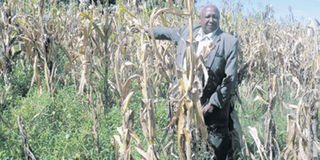Agriculture ministry to release report on virulent maize disease

PHOTO | FILE | NATION
Mr Samwel Soi, a Bomet farmer, shows his maize crop that was infested by a disease.
What you need to know:
Sources say farmers in the South Rift have been most affected by the disease and crop harvests will be dismal
The ministry of Agriculture will release a report this week to clear the air on a maize disease that could threaten food supply in the country.
The report was commissioned after farmers said they were worried that the spread of the maize lethal necrosis disease would have devastating effects on the country’s food supply.
Experts have handed the report to Agriculture permanent secretary Dr Romano Kiome, who is expected to release it in coming days, sources at the ministry told the Sunday Nation.
The disease that was first detected in the South Rift is set to change farming methods, especially in the North Rift where farmers rarely practise crop rotation.
But some large-scale farmers in the region are reluctant to plant crops other than maize and wheat.
Farmers have faulted the government for the way information on the maize disease has been disseminated.
“The government is creating unnecessary anxiety just like it happened during the debate on genetically modified crops,” said Kipkorir arap Menjo, a Kenya Farmers Association director. “Now any disease that affects maize is being associated with MLN, and this is because little information is coming from the experts.”
A senior official at Kilimo House, who did not wish to be named discussing a port that is yet to be released to the public, said the South Rift was the only affected region.
The report is a culmination of countrywide research by the ministry in conjunction with research institutions, seed companies and farmers’ representatives.
“Other major maize-growing areas have not been affected much,” the official said.
He sought to allay fears that the country coudl be in for a maize shortage. Millers had estimated that the disease would cut production by 30 per cent.
“We are not likely to import food because of this disease,” the official said.
He said areas that experience rainfall throughout the year and irrigated farms were at risk because the mature maize is likely to infect the growing crop.
“This perpetuates the disease. One should harvest and let the farm rest. The best approach is to introduce another crop instead of repeating the same crop year round,” the agriculture official said. He cited Borabu, Bomet and Chepalungu as the areas that may suffer low yields due to the disease.




